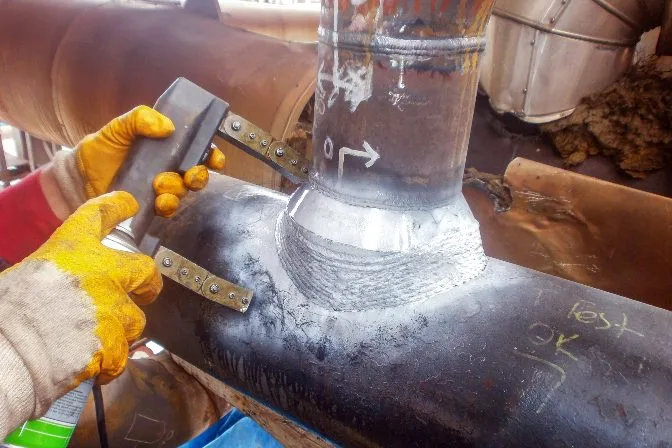Just How Tank Welding Inspection Avoids Future Structural Failings
The Vital Function of Container Welding Examination in Ensuring Structural Stability and Security Compliance in Industrial Applications
In the realm of commercial applications, tank welding assessment arises as an essential component in securing architectural integrity and making certain conformity with safety and security laws. Using a combination of techniques such as visual assessments and progressed testing approaches, these assessments offer to identify and alleviate prospective imperfections before they escalate into significant threats.
Relevance of Storage Tank Welding Examination

Ensuring conformity with industry standards and regulations is another substantial aspect of container welding inspection. Governing bodies mandate strict standards for the building and upkeep of tank, and extensive inspections help organizations follow these needs. Non-compliance can result in extreme fines, consisting of fines and shutdowns, even more emphasizing the need for strenuous evaluation protocols.
Furthermore, tank welding evaluation plays an essential duty in maintaining operational performance. Normal evaluations can identify potential problems prior to they escalate, assisting in prompt repairs and decreasing downtime. This proactive approach not just improves safety and security but also adds to cost savings in the future. In summary, the value of tank welding examination depends on its ability to secure public health and wellness, shield the setting, and ensure conformity with regulatory frameworks.
Trick Evaluation Strategies
Effective container welding evaluation counts on a range of key techniques that make sure extensive assessment of weld quality and architectural integrity. Among the most common techniques are visual evaluation, ultrasonic testing, radiographic testing, and magnetic fragment testing - Tank Welding Inspection. Each approach supplies one-of-a-kind advantages in assessing various elements of the weld
Visual examination works as the initial line of defense, enabling assessors to identify surface issues, irregularities, or disparities in the weld grain. Ultrasonic screening utilizes high-frequency audio waves to spot interior problems, such as fractures or gaps, offering a comprehensive analysis of weld honesty. This technique is especially efficient in spotting problems that may not be noticeable on the surface area.
Radiographic testing uses X-rays or gamma rays to create pictures of the welds, disclosing interior stoppages and providing a long-term document for future recommendation. This method is highly reliable for vital applications where the threat of failure should be minimized.
Last but not least, magnetic bit screening is used to determine surface area and near-surface issues in ferromagnetic materials. By using electromagnetic fields and great iron fragments, assessors can identify stoppages that could compromise the structural integrity check this of the tank. Together, these techniques develop a robust framework for ensuring high-grade welds in industrial applications.
Conformity With Security Criteria

Normal examinations play an essential duty in guaranteeing conformity by recognizing possible failures or discrepancies from suggested criteria. Inspectors are trained to evaluate weld top quality, validate product requirements, and analyze the general structural honesty of containers. Their experience is essential in ensuring that welding procedures meet the required security standards.
Moreover, compliance with safety and security requirements not just safeguards workers but additionally safeguards the atmosphere from prospective hazards such as leaks or devastating failures. Organizations that focus on security compliance are better placed to reduce risks, boost functional effectiveness, and foster a culture of safety and security within their labor force. In summary, preserving strenuous compliance with security criteria is indispensable for the successful operation of tank welding tasks in commercial setups.
Benefits of Regular Evaluations
Regular inspections are important to keeping the structural honesty and safety and security of welded storage tanks. These examinations give an organized technique to identifying possible issues or weaknesses in the welds, guaranteeing that any kind of concerns are addressed before they rise into significant failings. By conducting routine evaluations, organizations can detect deterioration, exhaustion, and various other kinds of deterioration that may endanger container efficiency.
Additionally, constant evaluations add to compliance with market laws and requirements. Abiding by these guidelines not just mitigates lawful threats yet also improves the organization's credibility for safety and dependability. Normal assessments promote a positive safety society, motivating staff members to acknowledge and focus on the significance of tools integrity.

Study and Real-World Applications
Situation researches and real-world applications show the substantial influence of efficient storage tank welding assessment practices. One remarkable example is a large petrochemical center that dealt with significant functional disruptions as a result of leaks in tank. Complying with the application of rigorous welding inspection methods, consisting of visual and ultrasonic screening, the facility determined essential imperfections in weld seams that could have brought about devastating failures. This aggressive technique not only stopped ecological hazards yet likewise saved the company millions in prospective cleanup prices and governing penalties.
Likewise, a water therapy plant applied a thorough assessment program for its tank welding operations - Tank Welding Inspection. By including non-destructive screening techniques, the plant had the ability to spot early indications of rust and exhaustion in weld joints. This prompt treatment extended the life expectancy of the tanks and made certain conformity with safety regulations, hence guarding public health and wellness
These study underscore the importance of normal and methodical container welding evaluations. By focusing on these techniques, industries can minimize threats, enhance structural stability, and make certain compliance with safety and security requirements, ultimately resulting in boosted operational effectiveness and minimized responsibilities.

Verdict
In final thought, container welding evaluation is an indispensable part of keeping structural integrity and security in commercial applications. Using numerous evaluation strategies makes sure very early detection of prospective problems, thus stopping devastating failures. Adherence to security requirements even more improves functional reliability and conformity with regulatory demands. Inevitably, regular evaluations not only protect public health and wellness and the setting however likewise contribute to the long life and performance of crucial properties, underscoring the essential duty of this practice in industrial operations.